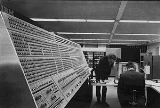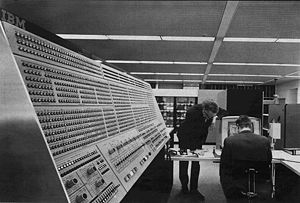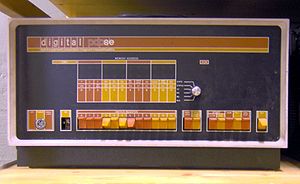
Front panel
Encyclopedia

Computer memory
In computing, memory refers to the physical devices used to store programs or data on a temporary or permanent basis for use in a computer or other digital electronic device. The term primary memory is used for the information in physical systems which are fast In computing, memory refers to the...
. The front panel usually consisted of arrays of indicator lamp
Lamp (electrical component)
A lamp is a replaceable component such as an incandescent light bulb, which is designed to produce light from electricity. These components usually have a base of ceramic, metal, glass or plastic, which makes an electrical connection in the socket of a light fixture. This connection may be made...
s, toggle switches, and push button
Button (control)
A push-button or simply button is a simple switch mechanism for controlling some aspect of a machine or a process. Buttons are typically made out of hard material, usually plastic or metal. The surface is usually flat or shaped to accommodate the human finger or hand, so as to be easily depressed...
s mounted on a sheet metal face plate. In early machines, CRT
Cathode ray tube
The cathode ray tube is a vacuum tube containing an electron gun and a fluorescent screen used to view images. It has a means to accelerate and deflect the electron beam onto the fluorescent screen to create the images. The image may represent electrical waveforms , pictures , radar targets and...
s might also be present (as an oscilloscope, or, for example, to mirror the contents of Williams-Kilburn tube
Williams tube
The Williams tube or the Williams-Kilburn tube , developed in about 1946 or 1947, was a cathode ray tube used to electronically store binary data....
memory).
On some machines, certain lights and switches were reserved for use under program control. These were often referred to as sense lights and sense switches. For example, the original Fortran
Fortran
Fortran is a general-purpose, procedural, imperative programming language that is especially suited to numeric computation and scientific computing...
compiler for the IBM 704
IBM 704
The IBM 704, the first mass-produced computer with floating point arithmetic hardware, was introduced by IBM in 1954. The 704 was significantly improved over the IBM 701 in terms of architecture as well as implementations which were not compatible with its predecessor.Changes from the 701 included...
contained specific statements for testing and manipulation of the 704's sense lights and switches.
Operating systems made for computers with blinkenlights
Blinkenlights
Blinkenlights is a hacker's neologism for diagnostic lights on old mainframe computers and modern network hardware.The Jargon File provides the following etymology:...
, for example, RSTS/E
RSTS/E
RSTS is a multi-user time-sharing operating system, developed by Digital Equipment Corporation , for the PDP-11 series of 16-bit minicomputers. The first version of RSTS was implemented in 1970 by DEC software engineers that developed the TSS-8 time-sharing operating system for the PDP-8...
and RSX-11
RSX-11
RSX-11 is a family of real-time operating systems mainly for PDP-11 computers created by Digital Equipment Corporation , common in the late 1970s and early 1980s. RSX-11D first appeared on the PDP-11/40 in 1972...
, would frequently have an idle
Idle (CPU)
A computer processor is described as idle when it is not being used by any program.Programs which make use of CPU Idle Time mean that they run at a low priority so as not to impact programs that run at normal priority...
task blink the panel lights in some recognizable fashion. System programmers often became very familiar with these light patterns and could tell from them how busy the system was and, sometimes, exactly what it was doing at the moment.
This baroque style of front panels began to die out in 1964 when Seymour Cray
Seymour Cray
Seymour Roger Cray was an American electrical engineer and supercomputer architect who designed a series of computers that were the fastest in the world for decades, and founded Cray Research which would build many of these machines. Called "the father of supercomputing," Cray has been credited...
designed his first supercomputer
CDC 6000 series
The CDC 6000 series was a family of mainframe computers manufactured by Control Data Corporation in the 1960s. It consisted of CDC 6400, CDC 6500, CDC 6600 and CDC 6700 computers, which all were extremely rapid and efficient for their time...
with a very simple and elegant display console containing only 2 CRT
Cathode ray tube
The cathode ray tube is a vacuum tube containing an electron gun and a fluorescent screen used to view images. It has a means to accelerate and deflect the electron beam onto the fluorescent screen to create the images. The image may represent electrical waveforms , pictures , radar targets and...
displays and a keyboard
Keyboard (computing)
In computing, a keyboard is a typewriter-style keyboard, which uses an arrangement of buttons or keys, to act as mechanical levers or electronic switches...
, replacing all the hundreds of switches, buttons, and blinking lights.
Early microcomputers such as the 1975 Altair 8800
Altair 8800
The MITS Altair 8800 was a microcomputer design from 1975 based on the Intel 8080 CPU and sold by mail order through advertisements in Popular Electronics, Radio-Electronics and other hobbyist magazines. The designers hoped to sell only a few hundred build-it-yourself kits to hobbyists, and were...
also relied on front panels, but since the introduction of the Apple II
Apple II
The Apple II is an 8-bit home computer, one of the first highly successful mass-produced microcomputer products, designed primarily by Steve Wozniak, manufactured by Apple Computer and introduced in 1977...
in June 1977, the vast majority of micros came with keyboards and connections for TV screens or other monitors.
Common usage
An operatorComputer operator
A role within IT, computer operators oversee the running of computer systems, ensuring that the machines are running and physically secured. The traditional role of a computer operator was to work with mainframes which required a great deal of management day-to-day, however nowaday they often work...
would stand at the front panel to bootstrap
Booting
In computing, booting is a process that begins when a user turns on a computer system and prepares the computer to perform its normal operations. On modern computers, this typically involves loading and starting an operating system. The boot sequence is the initial set of operations that the...
the computer, to debug running programs, and to find hardware
Computer hardware
Personal computer hardware are component devices which are typically installed into or peripheral to a computer case to create a personal computer upon which system software is installed including a firmware interface such as a BIOS and an operating system which supports application software that...
faults. Typically, the operator would read from a scrap of paper containing a short series of bootstrap instructions that would be hand-entered using the toggle switches. First, the operator would set the "address" switch, and enter the address in binary using the switches. Then the operator would set the "value" switch, and then enter the value intended for that address. After punching in a dozen or so of these instructions (most computers had a "deposit next" button, which would deposit subsequent values in subsequent addresses, relieving the operator of needing to toggle in addresses), the operator would then set the starting address of the bootstrap program and press the "run" switch to begin the execution of the program. Often, the bootstrap would turn on the punched tape reader, which would load a somewhat longer program, which in turn would load the operating system from disk.
Some machines accelerated the bootstrap process by allowing the operator to set the switches to one or two machine language
Machine code
Machine code or machine language is a system of impartible instructions executed directly by a computer's central processing unit. Each instruction performs a very specific task, typically either an operation on a unit of data Machine code or machine language is a system of impartible instructions...
instructions and then directly executing those instructions. Other machines allowed I/O devices to be explicitly commanded from the front panel (for example, "Read-In Preset" on the PDP-10
PDP-10
The PDP-10 was a mainframe computer family manufactured by Digital Equipment Corporation from the late 1960s on; the name stands for "Programmed Data Processor model 10". The first model was delivered in 1966...
or the accessing of memory-mapped I/O
Memory-mapped I/O
Memory-mapped I/O and port I/O are two complementary methods of performing input/output between the CPU and peripheral devices in a computer...
devices on a PDP-11
PDP-11
The PDP-11 was a series of 16-bit minicomputers sold by Digital Equipment Corporation from 1970 into the 1990s, one of a succession of products in the PDP series. The PDP-11 replaced the PDP-8 in many real-time applications, although both product lines lived in parallel for more than 10 years...
). Some machines also contained various bootstrap programs in ROM
Read-only memory
Read-only memory is a class of storage medium used in computers and other electronic devices. Data stored in ROM cannot be modified, or can be modified only slowly or with difficulty, so it is mainly used to distribute firmware .In its strictest sense, ROM refers only...
and all that was required to boot the system was to start it executing at the address of the correct ROM program.
Entertainment
For fun, bored programmers would create programs to display animated light shows. Front panels in the late 1960s and early 1970s were quite brightly colored. When bootstrap ROMRead-only memory
Read-only memory is a class of storage medium used in computers and other electronic devices. Data stored in ROM cannot be modified, or can be modified only slowly or with difficulty, so it is mainly used to distribute firmware .In its strictest sense, ROM refers only...
s enabled computers to start themselves without operator intervention in the late 1970s and early 1980s, most computers were built without a front switch panel. High-powered calculators, such as the HP 9830
HP 9830
The HP 9800 was a family of what were initially called programmable calculators and later desktop computers made by Hewlett-Packard, replacing their first HP 9100 calculator...
based on ROM
Read-only memory
Read-only memory is a class of storage medium used in computers and other electronic devices. Data stored in ROM cannot be modified, or can be modified only slowly or with difficulty, so it is mainly used to distribute firmware .In its strictest sense, ROM refers only...
, were among the first computers to do away with front panels, and operators.
Huge banks of "blinkenlights" and "blowenfuzen" were featured on TV and movies as the popular image of the "computer" during the 1950s to 1970. (A Burroughs B205 was used as a Hollywood prop for many of these shows.)
Example

RK05
The RK05 DECpack was a moving head magnetic disk drive manufactured by the Digital Equipment Corporation of Maynard, Massachusetts. It stored approximately 2.5 MB on a 14", single-platter IBM-2315-style front-loading removable disk cartridge. The cartridge permitted users to have relatively...
moving-head magnetic disk
Magnetic storage
Magnetic storage and magnetic recording are terms from engineering referring to the storage of data on a magnetized medium. Magnetic storage uses different patterns of magnetization in a magnetizable material to store data and is a form of non-volatile memory. The information is accessed using...
on a PDP-8
PDP-8
The 12-bit PDP-8 was the first successful commercial minicomputer, produced by Digital Equipment Corporation in the 1960s. DEC introduced it on 22 March 1965, and sold more than 50,000 systems, the most of any computer up to that date. It was the first widely sold computer in the DEC PDP series of...
system:
- Ensure that the machine is halted by lowering and raising the Halt switch; the front panel "RUN" light should then be off.
- Set the 12 data switches to 0030 (Octal address 30), depress the Load Address ("ADDR LOAD") switch. The address lights will change to "0030".
- Set the switches to 6743, raise the Deposit switch. The data lights will show this instruction.
- Set the switches to 5031, raise the Deposit switch. The data lights will show this instruction.
- Set the switches to 0030 (Octal address 30), depress the Load Address switch. The address lights will change back to "0030".
- Depress the Clear switch.
- Depress the Continue switch. The "RUN" light will illuminate and the operating system on the disk will be bootstrapped.
This process works by depositing a simple, two-instruction program in memory and executing it. The first instruction commands the disk controller to begin reading the disk from the current disk address into the current memory address. The second instruction is a JMP instruction that jumps to itself endlessly. When "Clear" is pressed, the disk controller's current disk address is set to sector 0 and its current memory address is set to memory location 0000. When the read is commanded, the program stored in disk sector 0 overlays the bootstrap program and, once the JMP instruction is overlayed, the disk program takes control of the machine.

